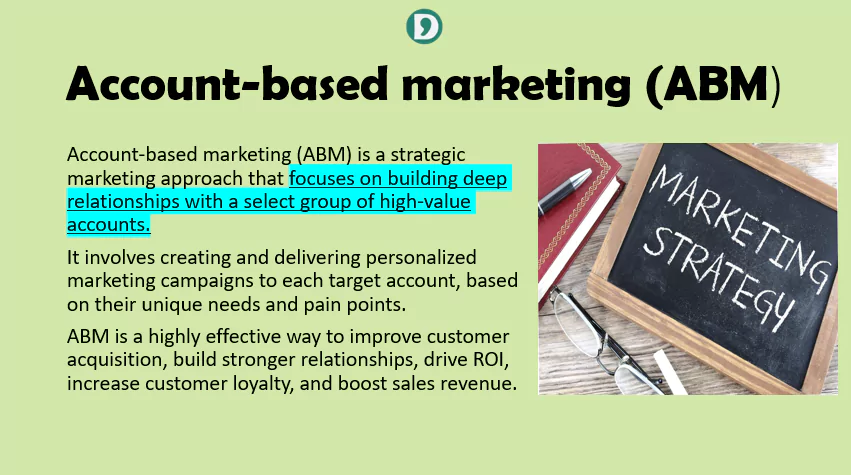Introduction
Account-based marketing (ABM) is a focused marketing strategy that treats each key customer or prospect as a unique market. Instead of casting a wide net and hoping to attract a broad audience, ABM targets specific, high-value accounts with personalized marketing campaigns.
Basically, This approach help to build good relationships with these accounts, and to increased revenue and customer lifetime value.
Definition of Account based Marketing
“Account-based marketing (ABM) is a strategic approach to marketing that focuses on building deep relationships with a select group of high-value accounts. ABM involves creating and delivering personalized marketing campaigns to each target account, based on their unique needs and pain points.” -Engler, R. L., & Aaker, D. A.
“Account-based marketing (ABM) is a strategic marketing approach that focuses on building and maintaining relationships with targeted accounts. ABM involves developing and executing personalized marketing campaigns that are design to influence the buying decisions of key decision-makers at these accounts.” – Ingram, J. G., & Smith, R. J.
“Account-based marketing (ABM) is a strategic marketing approach that focuses on identifying, targeting, and engaging a select group of high-value accounts. ABM involves personalizing marketing campaigns to the specific needs and pain points of each target account, with the goal of building long-term relationships and driving revenue.” – Kottler, P. T., Keller, K. L., Koshy, A., & Jha, M
Key Elements of ABM

- Targeting: ABM starts with identifying and prioritizing a select group of accounts that align with your company’s ideal customer profile (ICP). These accounts are often chosen based on factors such as industry, size, revenue potential, and strategic fit.
- Personalization: ABM goes beyond generic messaging and tailors marketing efforts to the specific needs and challenges of each target account. This personalization can involve creating customized content, engaging with relevant decision-makers, and demonstrating how your company’s solutions address their unique pain points.
- Collaboration: ABM requires close collaboration between sales and marketing teams. Sales reveals insights about target accounts and their priorities. Marketing creates customized campaigns that are in line with the messages of the sales team. This is what aligns for a consistent and unified customer experience.
Benefits of Account-Based Marketing (ABM)
- Improved Customer Acquisition: ABM’s focused approach leads to more qualified leads and a higher conversion rate, improving customer acquisition efficiency.
- Stronger Customer Relationships: By treating each account as a market, ABM fosters deeper relationships with key customers, building trust and loyalty.
- Enhanced ROI (Return on Investment): ABM’s targeted approach allows for more effective resource allocation, resulting in a higher return on investment for marketing and sales efforts.
- Increased Customer Lifetime Value: ABM nurtures long-term relationships with key accounts, increasing the likelihood of repeat business and expanding customer lifetime value.
Types of ABM
- Strategic or One-to-One ABM: This involves personalized marketing campaigns for a small number of the most critical accounts.
- ABM Lite or One-to-Few: This targets a larger group of high-value accounts with a more scalable approach, still maintaining a degree of personalization.
- Programmatic ABM or One-to-Many: This utilizes automated marketing tools to personalize campaigns for a broader set of target accounts, balancing personalization with efficiency.
Key Differences between ABM and Traditional Marketing:
- Segmentation: Traditional marketing segments a broader audience based on demographics or common traits, while ABM segments based on specific accounts and their unique characteristics.
- Messaging: Traditional marketing relies on generic messaging, while ABM personalizes messaging to address the specific needs and priorities of each target account.
- Measurement: Traditional marketing often measures success by metrics like website traffic or lead volume, while ABM focuses on account-level metrics like customer acquisition, revenue generated, and customer lifetime value.
Account-based marketing is a strategic approach that moves away from a general audience to a specific set of valuable accounts. Through personalization of marketing initiatives and developing strong connections, ABM used to enhance customer acquisition, promote relationship building, maximize ROI, convert loyalty levels, and increase sales revenues..
Was this helpful?
1 / 0